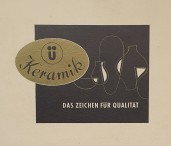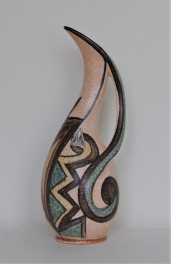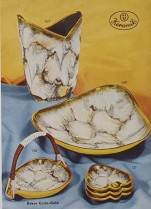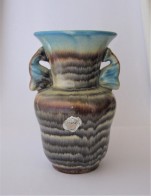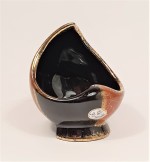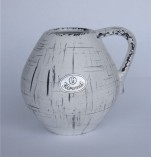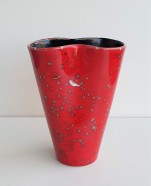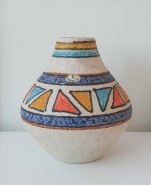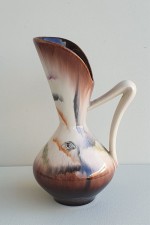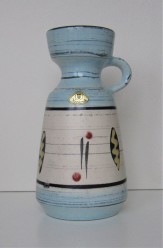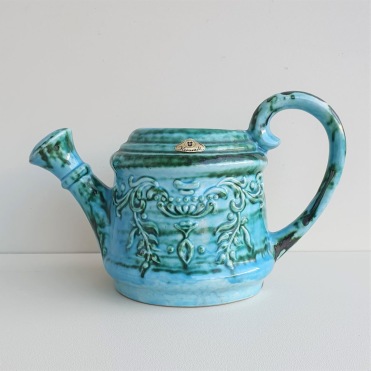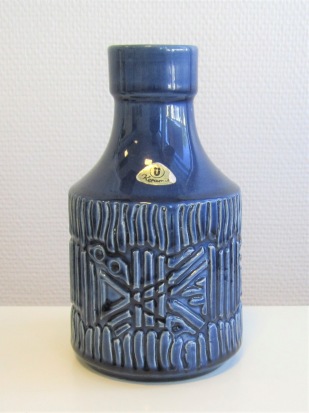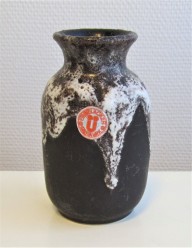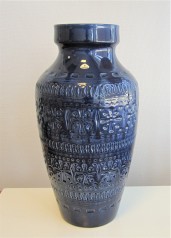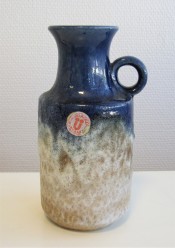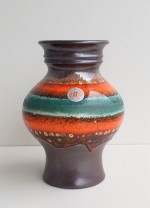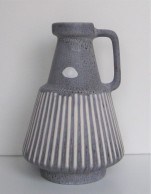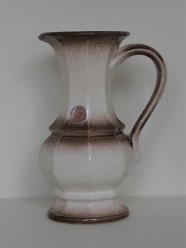Uebelacker 1909-1990
History
Keramikfabrik Uebelacker in Ransbach/Westerwald was one of the larger ceramic manufacturer from the 50s to the late 70s. There is not much information to find about this company. The most important source with information about Uebelacker is Horst Makus book "Keramik der 50er Jahre".
In 1909 Johann Uebelacker founded a tin foundry in Ransbach. In the 20s he started to produce porcelain stoneware and from the 30s also glazed ceramics. A sister company "Siershahner Feinsteinzeugfabrik" was founded 1949 with production in Siershahn and later also in Mogendorf. Johann Uebelacker died in the mid 50s (some sources say 1955) and his three sons took over the businesses. In 1955 the two companies had more than 550 employees. Uebelacker exported a lot of ceramics, escpecially to Austria and to the Scandinavian countries. The failed expansion of another factory, Kilrush Ceramics in Ireland, caused the company financially problems. The comapany filed for bancrupsy in the early 1990.
Shapes and decors
Uebelacker is not famous for any popular forms or decors and its designers are relatively unknown. The company followed the general trends with the ceramic industry. Jugend/Art Nouveau inspired decors were popular during the 40s and early 50s. The colours of the glazes were limited by the teqnique in the 40s and are mostly discrete brown, grey and green. In the 50s the glaze teqniques developed fast and Uebelacker was the first company to mass produce a red glaze made from selenium 1954.
Uebelacker 386, 388 and 379. The glase is probably one of the selenium red glazes Heinz Hommerich introduced 1954.
In the mid 50s painted geometric patterns became popular in the ceramic industry. One of the best examples from Uebelacker is the decor "Diana" from 1953-1955.
Another example of a more experimental glaze is the series "Craquelé" from 1952-1953 that had a glossy glaze with a fine net of cracks. Ackording to Makus book this series was extended with "Craquelé gold" 1954. This means that Uebelacker had Gold glazes from 1954 and onwards.
The catalog fron März 1957 contain 13 main decors which of 4 also could have gold added to the rims. The main decors are both organic patterns like Mona and more strict geometric patterns like Anita. The catalog shows that the trend was towards more advanced and colorful glazes that became typical for the 60s.
Designers
Heinz Hommerich
1949-1976
Ursula Schönhaber
1959-1963
Leonhard Stieger
1948-1972
Gerhard Stein 1947-1966
Uebelacker E1. This decor is similar to the decors in the Diana series. The vase has the ordinary Uebelacker label used 1950-1954. It could be a pre Diana series decor and it could therefore be from the period 1950-1952.
Uebelacker 379. Decor Diana from 1953-1955. The form is asymmetric and Uebelacker introduced several asymmetric forms in the early 50s.
The glaze "Craquelé from 1952-1953.
Uebelacker 207. This two armed candle holder is inspired by the Jugend/Art Nouveau style. It is typical for the 40s and contiuned to be popular during the early 50s.
Uebelacker 364/12. This amphora styled vase with leafs on the handles is also an example of the Jugend/Art Nouveau style. The glaze is typical for early Uebelacker vases from the late 40s - early 50s.
Uebelacker 132. This vase is fron 1955-1959? Gold decors became popular in the mid 50s and Uebelacker had Gold decors as early as 1954.
Uebelacker 378. An example of a bright red glaze from the end of the 50s. This vase is from 1955-1959?
Uebelacker 456/17. Geometric patterns like this one were popular in the early 60s.
This vase is from 1960-1963?
At the end of the 60s Uebelacker as well as most other ceramic producers introduced advanced forms with moulded patters. In the early 70s fat lava style glazes were developed. Uebelacker has done many good examples of both moulded patterns and fat lava style glazes but only a few has become "famous" among collectors. "chimney" or "block" vases with the form numbers 1441, 1442, 1443, 1444, 1445, 1446, 1447 that has a fat lava glaze are very popular among collectors today.
Uebelacker 303/15. A water pitcher with a floral relief decor. This pitcher is from 1964-1969?
Uebelacker 1236/17. This form has a very deep relief decor.
This vase is from 1964- 1969?
Uebelacker 1435/12.
Fat lava glazes were introduced in the
early 70s. This vase is from 1970-1974?
Uebelacker 1130/50. This is a very large floor vase with a relief decor typical for the end of the 60s. This vase is from 1964-1969?
Uebelacker 1756/18.
This is an example of a clear blue glaze covered of a white lava glaze. This vase is from 1970-1974?
Uebelacker production from the 80s is less interesting among collectors since the general trend in the industry was more simple and less artistic form and glazes. However Uebelackers last produced ceramics was probably a series of handmade vases that has a more artistic feeling since they were handmade.
Uebelacker 1514/19R. This decor has also a relief pattern. The form has more straight, rough lines which was common in the late 60s early 70s. This vase is from 1964-1969?

